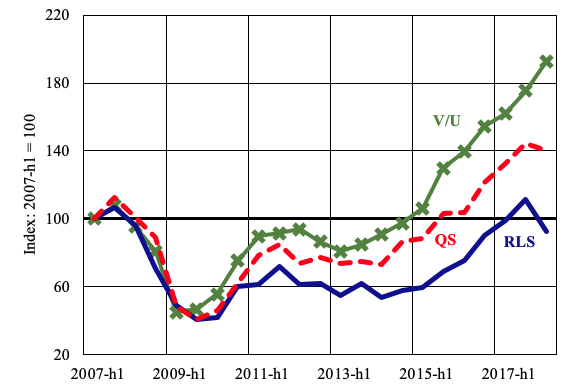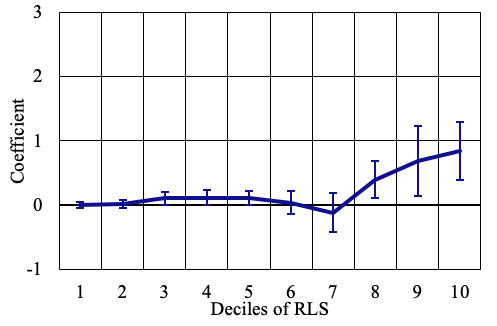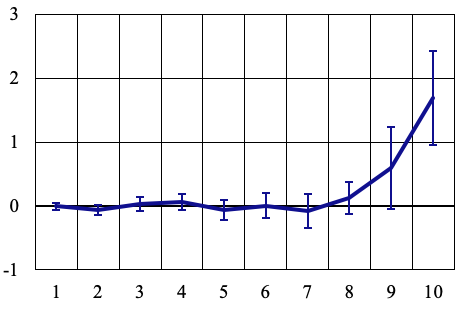By Erik Frohm, Senior Economist, Sveriges Riksbank. Originally published at VoxEU.
Until the outbreak of the Covid-19 crisis, wage growth had remained sluggish in many advanced economies, while labour markets appear to have improved substantially. This column argues that real-time indicators based on qualitative survey data provided an overly optimistic picture of labour market conditions in the aftermath of the Great Recession. A new establishment-level measure in Sweden, that utilises survey respondents’ quantitative assessments of labour shortages, overcomes some of the shortcomings of purely qualitative data and indicates that labour markets have typically been much weaker than initially assumed during the recovery. As labour shortages are strongly correlated with wage growth at the establishment level, their lower level can help explain why wage growth in Sweden has been sluggish.
“… there is still a bit of a puzzle in that we’re hearing about labour shortages now all over the country in many, many different occupations in different geographies. … I would have expected, that wages would move up a little bit more.” –Jerome Powell, chairman of the Federal Reserve Board in the United States.
Jerome Powell’s puzzle has also been prominent in many other advanced economies, Sweden included (Sveriges Riksbank 2017). For example, in its flagship report released in December of 2018, the Swedish central bank estimated that the output gap in Sweden had been positive for three consecutive years. Over those same years, nominal wage growth had not budged and remained stable at around 2.5%.
Although estimates of unobserved variables such as ‘potentials’ or ‘natural rates’ are uncertain in real time (Orphanides and van Norden 2002), survey-based indicators pointed to continuously improving labour market conditions during the recovery from the Great Recession. This gave policymakers confidence in their assessment of high resource utilisation, tight labour markets, and an impending increase in inflation. But as I show in this column based on my recent paper (Frohm 2020), qualitative indicators can also give a biased picture of real-time labour market conditions. This was particularly the case in the period after the Great Recession.
An Establishment-Level Measure of Labour Shortages
With establishment-level data from the Swedish Public Employment Service’s interview survey (Arbetsförmedlingens intervjuundersökning, or AFU), which is a large representative business survey, I construct a quantitative measure of labour shortages. The surveys asks respondents (1) if they perceived labour shortages in connection to recruitment over the past six months, and if so (2) how many positions they experienced shortages in. The measure of labour shortages is computed as the ratio of number of labour shortages to total employment at the establishment. This measure of relative labour shortages is continuous and relative: a higher value reflects increasing labour shortages relative to employment at establishment level, as is typically expected during a period of labour-market tightening. Similarly, a lower value means that establishments are experiencing fewer labour shortages and indicate a looser labour market.
Figure 1 shows relative labour shortages compared to the purely qualitative indicator of labour shortages computed from the same survey, which is the ratio of respondents experiencing labour shortages to the total number of responses alongside the conventional (quantitative) vacancy-to-unemployment ratio, indexed to 100 in 2007h1. From the beginning of 2011 and onward, relative labour shortages developed markedly weaker than both qualitative shortages and the vacancy-to-unemployment ratio. Moreover, and contrary to the other indicators, relative labour shortages only exceeded their pre-crisis level in the second half of 2017, before falling back in the first half of 2018. By contrast, both the qualitative shortages and vacancy-to-unemployment ratio indicators regained their pre-crisis levels back in 2015 and have been suggestive of stronger labour market conditions throughout the post-crisis period than relative labour shortages.
The reason why relative labour shortages indicate more labour market slack than the other survey-based measure is that they provide information on the supply and demand of labour from a recruiting firm’s perspective, rather than providing merely the direction of labour market tightness in case of the qualitative indicator (i.e. the proportion of respondents experiencing labour shortages). The fact that the measures diverge tells us that an increasing number of respondents were perceiving labour shortages during the recovery, but that their quantitative assessment of labour shortages was decreasing.
Figure 1 Relative labour shortages (RLS) and other indicators

Source: Frohm (2020) and National Institute of Economic Research (NIER).
Notes: Index: 2007h1 = 100. QS (the dashed line) is simply the share of respondents that responded “Yes” to whether or not they experienced labour shortages in connection to recruitment over the past six months. V/U (the crossed line) is the vacancy-unemployment ratio measured as total number of vacancies as percent of the labour force, over unemployed persons as percent of the labour force in the age group 15-74 years retrieved from the Swedish National Institute of Economic Research. RLS (the solid line) is the average ratio of number of positions where respondents experienced labour shortages to total employment at the establishment.
Signs of a Non-Linear Relationship between Labour Shortages and Wage Growth
As the AFU survey also collects respondents’ assessments of their current average annual nominal wage growth, I show that relative labour shortages are correlated with wage growth at the establishment level. With establishment, sector-time (controlling for, for example, sector-level productivity or negotiated wages) and region-time fixed effects (controlling for regional labour market conditions) for a sub-sample of establishments that have participated in more than three-quarters of all survey waves (around 6,000 establishments), there is evidence of wages responding non-linearly to relative labour shortages (see Figure 2). Wage growth is estimated to be about 0.8 percentage points higher for establishments with relative labour shortages in the 10th decile than if relative labour shortages = 0. Moreover, the relationship appears to materialise only when relative labour shortages are at higher levels.
These results hold irrespective if unweighted estimates are used (panel A) or those with sample weights (panel B). In a nutshell, this new evidence suggest that labour markets in Sweden would have to tighten considerably more to increase wage growth, in line with the theoretical analyses of Daly and Hobjin (2014) and Lindé and Trabandt (2019), as well as aggregate empirical analyses by Byrne and Zekaite (2018) and Nickel et al. (2019) for the euro area.
Figure 2 Estimated impact of deciles of relative labour shortages on nominal annual wage growth
(A) Unweighted estimates

(B) With sample weights

Source: Frohm (2020).
Some Caution in the Use of Qualitative Survey Indicators
Policymakers often use qualitative surveys as cross-checks for estimates of unobserved variables, like the output gap or unemployment gap. However, the evidence in this column suggests that while surveys reporting simply qualitative indicators (or labour market indicators reflecting changes in the numbers of unemployed, rather than those employed) may reasonably capture turning points, they may provide misleading signals as to the degree of labour market tightness – particularly in the aftermath of severe downturns.
This analysis is highly policy relevant. Several members of the Executive Board of the Swedish central bank highlighted record-level labour shortages as part of their assessment of the economic conditions at the December 2018 Monetary Policy Meeting, when the decision to begin tightening monetary policy was taken (Sveriges Riksbank 2018b). As my analysis shows, qualitative surveys of labour shortages likely underestimated the true degree of labour market slack in the recovery from the Great Recession and thus provided an overly strong signal for wage growth and inflation.
In the aftermath of the current Covid-19 crisis, there is a risk that respondents’ reference levels change again. By how much, and in what direction will likely be determined by the timing, length, and strength of the ensuing recovery.
Authors note: The opinions expressed in this column are the sole responsibility of the author and should not be interpreted as reflecting the views of Sveriges Riksbank. I am very grateful to Valerie Jarvis for thoughtful comments and suggestions.


(Why are Comments OFF for today’s links?)
All the settings are ON. I’m looking into it.
Ditto to ‘flora.’
A DDoC attack? (Distributed denial of comments.)
Perhaps, “The Revenge of Google!” [Other related “C” {for commerce} movie titles: “I Married an Amazon From Warehouse Space!”, “I Was A Terrorist For The FBI!”, “Mitch and Nancy”, and that old favourite, “The Thing From Jeckyll Island!”]
From the recruiting firm’s perspective, I would think there’s always a shortage of qualified workers who dont’t need training willing to accept lower pay.
Firms quit traiing years ago. They routinely demand more experience than is practically possible (5 years experience in a technology 3 years old). They accept the best they can get and rely on “on the job self-training.” Resume deception is rampant.
When jobs were simpler and routine, HR could adequately spec for them. But in today’s modern economy they are out of their league. From what I’ve read, there is historical tension in HR between commodification vs humanization.
A couple of years back then I read that the definition for a job-market in balance in Sweden was if there was 8 (eight) qualified applicants per open position, shortage was when there as less than 3 (three) qualified applicants per open position. I hope that what I read was never true, however, based on how spoiled employers are I found it to be credible.
As far as I can tell the only way to tell if there is a shortage is if the price (wage) increases, the market based approach. But that would be based on the assumption of a perfect and competitive market.
One other measure, closely correlated to wage, might be how long employees stays with an employer – if there is a shortage then employers might compete (unless they agree not to compete for employees, it has happened in the US and it has been claimed to happen also in Sweden….) for employees thus leading to high staff-turnover and wage increases.
Strong bargaining position for employees is likely to, in a competitive job-market without collusion, have higher staff-turnover than in a job-market where the bargaining position of the employees are weak. When employees fire their bosses by finding work for another boss then the job-market is strong for employees. (I love the expression about firing the boss)
The assumption of the perfect market is false, there is collusion in the job-market and in some cases there are even employers so dominant that they can dictate the price/wage.
& averages are sometimes useful, in this case then I’d say that the calculated averages are hiding so much information that policies based on these averages are likely to be very bad for parts of the population and it is impossible to know or even estimate how many would be negatively affected by the policy beforehand. Historically then I’d guess that the policies would benefit the few at the expense of the many…
https://en.wikipedia.org/wiki/The_devil_is_in_the_detail
So my opinion is that while the author of the anlysis claims that:This analysis is highly policy relevant I’d say in my opnion it is barely worth anything.
“Official” unemployment numbers are a bad joke. The public narrative in the US, for instance, pretends that the U3 represents unemployment, when it is the rarely reported U6 that is the broadest indicator of un-and-underemployment.
That’s the R4 and R8 for those of you playing the home game in “America’s Hat” …
In the Old Testament, working for wages is the exception, not the norm, for citizens. Nor is rent or debt slavery the norm either.
We’ve come a long way, baby…
A new restaurant was supposed to open in our neighborhood. Due to the pandemic, it’s opening has been at the very least, delayed, but maybe they’re planning to open at least for take-out because a sign has appeared in the front window: “Now recruiting cooks. $11 – $13 an hour, depending on experience.”
Man, the federal job guarantee and a $15 an hour federal minimum wage cannot come fast enough.
In the meantime, our local independent grocery store has ripped out 4 checkouts and reportedly is replacing them with automated self-checkout stations.
It’s hard to lament the loss of these very high risk, very low paid (even though union) jobs, and also hard to blame the owner. He is the third generation of his family to own and operate the market, which has been a great boon to the community. Most distributors won’t bother with him, as he is the owner of a single, small-ish store. Therefore, it’s very difficult for him to keep prices competitive–and of course there’s a Dollar General right across the street from him. Many people get their staples at DG, and then go to the grocery for produce and fresh meat. I can’t blame them, either. If they don’t economize on food, they can’t pay the rent.
Everybody getting squeezed, except those 400 billionaires and their toadies in Congress, etc…
Automation is in my opinion a good thing. There is no reason for people to do work they don’t need to do. The problem is finding other things to do. The mistake is making people starve when they can’t.
I remember listening to Freakanomics and discovering that economist make too many rosey assumptions about the labor market and don’t care to test them because of the potential guilt inducing results. They are a lot like politicians: sell it as a win-win and don’t talk about the losers.
Many workers don’t move on to more productive work. They earn less, do more menial jobs or fall out of the labor market. What you want is a pull by incentives, not a push into desperation.
Agree. And I think a federal Job Guarantee at a living wage could be that incentive.
The salary stagnation is moving up the hierarchy. As increasing numbers of college graduates, H1B holders, and foreign remote workers are able to credibly claim skills supply makes it happen. Labor is labor. The credentials are only really valuable when scarce.
Just my $0.02.
Also, for an indication of the value of the numbers watch unemployment through the lens of Shadowstats.com.